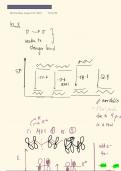Conjugated pi systems Study guides, Class notes & Summaries
Looking for the best study guides, study notes and summaries about Conjugated pi systems? On this page you'll find 30 study documents about Conjugated pi systems.
Page 2 out of 30 results
Sort by

-
Test Bank for Biochemistry Concepts and Connections 1st Edition by Dean R. Appling, Spencer J. Anthony-Cahill & Christopher K. Mathews , ISBN: 9780321839923 |COMPLETE TEST BANK| Guide A+
- Exam (elaborations) • 102 pages • 2024
-
- $19.99
- + learn more
Biochemistry: Concepts and Connections (Appling et al.) Chapter 1 Biochemistry and the Language of Chemistry 1) The water content in the human body is approximately: A) 90%. B) 80%. C) 70%. D) 60%. E) 50%. Answer: C 2) The four most abundant chemical elements in living systems are: A) hydrogen, oxygen, sulfur and phosphorus. B) hydrogen, carbon, nitrogen and oxygen. C) sodium, potassium, carbon and oxygen. D) sodium, potassium, nitrogen and sulfur. E) carbon, nitrogen, oxygen and potassium. Answ...
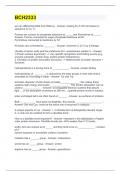
-
BCH2333 Questions and Answers
- Exam (elaborations) • 4 pages • 2024
-
- $7.99
- + learn more
BCH2333 we can differentiat DNA from RNA by - Answer- looking for 2'-OH and bases in sequence (U vs. T) Purines are connect to phosphate backbone at _____ and Pyrimidines at _____ - Answer- Purines connected to sugar phosphate backbone at N9 Pyrimidines connected to backbone by N1 All bases are connected to ________ - Answer- anomeric C (C1') by b-linkage chirality of amino acids and the preference for L-enantiomers results in: - Answer- 1.Protein surface asymmetry --> very sp...

-
Organic Chemistry: Conjugated Pi Systems
- Class notes • 10 pages • 2022
- Available in package deal
-
- $5.49
- + learn more
This document contains digitally taken, handwritten notes for the conjugated pi systems chapter. It covers topics on HOMO and LUMO structures, energy levels as well as molecule stability. Notes also cover information dienes, their nomenclature as well as their properties. Thoroughly explained subtopics include 1,2 and 1,4 addition, pericyclic reactions, Diel’s - Alder reaction as well as sigmatropic, Cope and Cleissen rearrangements. Notes show mechanism thoroughly and include explanation as n...
This document contains an overview of conjugated pi systems.
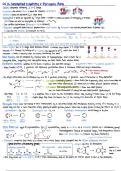
-
Conjugated pi systems and pericyclic reactions
- Class notes • 2 pages • 2024
- Available in package deal
-
- $7.99
- + learn more
Discusses how conjugation works, and how it affects stability and reactivity of a molecule. Includes information about nomenclature, and shows how pericyclic reactions work, including their mechanisms. The diels alder reaction is focused on.
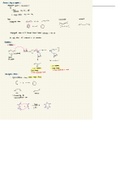
-
Organic Chemistry 2: Conjugated Pi Systems Summary
- Summary • 2 pages • 2022
- Available in package deal
-
- $5.49
- + learn more
This document is a summary of the conjugated pi systems chapter of the organic chemistry 2 course. It is digitally taken, handwritten notes. It covers topics on HOMO and LUMO structures, energy levels as well as molecule stability. Notes also cover information dienes, their nomenclature as well as their properties. Thoroughly explained subtopics include 1,2 and 1,4 addition, pericyclic reactions, Diel’s - Alder reaction as well as sigmatropic, Cope and Cleissen rearrangements. Notes show mecha...
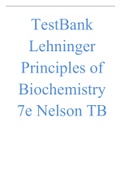
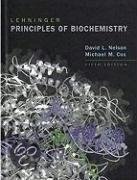
-
TestBank Lehninger Principles of Biochemistry 7e Nelson TB
- Exam (elaborations) • 560 pages • 2022
-
- $16.00
- + learn more
TestBank Lehninger Principles of Biochemistry 7e Nelson TB TestBank Lehninger Principles of Biochemistry 7e Nelson TBPage 1 1. In a bacterial cell, the DNA is in the: A) cell envelope. B) cell membrane. C) nucleoid. D) nucleus. E) ribosomes. 2. A major change occurring in the evolution of eukaryotes from prokaryotes was the development of: A) DNA. B) photosynthetic capability. C) plasma membranes. D) ribosomes. E) the nucleus. 3. In eukaryotes, the nucleus is enclosed by a d...
Conjugated pi systems and Diel Alder mechanism

-
BIO 3100 Test Banks
- Exam (elaborations) • 542 pages • 2022
-
Available in package deal
-
- $14.49
- + learn more
BIO 3100 Test Banks BIO 3100 Lecture Exam I-A February 14, 2008 1. Universal features of all living cells include all of the following except: (a) nucleus or nucleoid (b) plasma membrane (c) cytoplasm (d) centrosome 2. An open system is one (a) that exchanges neither matter nor energy with its surroundings plasma membrane (b) that exchanges energy but not matter with its surroundings. (c) that exchanges both matter and energy with its surroundings. (d) that exchanges matter but n...
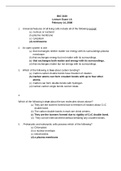
-
BIO 3100 Test Banks (A collection of the most tested Questions with Verified Answers) LATEST VERSION 2022.
- Exam (elaborations) • 542 pages • 2022
-
Available in package deal
-
- $14.49
- + learn more
BIO 3100 Test Banks BIO 3100 Lecture Exam I-A February 14, 2008 1. Universal features of all living cells include all of the following except: (a) nucleus or nucleoid (b) plasma membrane (c) cytoplasm (d) centrosome 2. An open system is one (a) that exchanges neither matter nor energy with its surroundings plasma membrane (b) that exchanges energy but not matter with its surroundings. (c) that exchanges both matter and energy with its surroundings. (d) that exchanges matter but not energy with i...

How much did you already spend on Stuvia? Imagine there are plenty more of you out there paying for study notes, but this time YOU are the seller. Ka-ching! Discover all about earning on Stuvia




